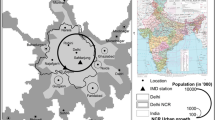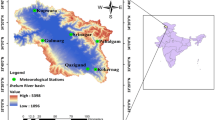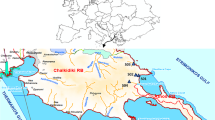Abstract
In most regions of the world, increased risk of extreme rainfall is identified as one of the most serious hazards, culminating in major flooding catastrophes that have resulted in losses of huge property and human life. As the frequency of extreme flash flood occurrences in Somalia has recently increased, this investigation focuses on modeling monthly extreme rainfall in Somalia during a 116-year period from 1901 to 2016 using a generalized extreme value (GEV) distribution, generalized Pareto distribution (GPD), r largest order statistics, and point process (PP) characterization. Negative log-likelihood, Akaike Information Criteria (AIC) and Bayesian Information Criteria (BIC) were applied to find out the optimal model for analyzing maximum rainfall in Somalia. The findings illustrate that GEV distribution with parameters location 60.354, scale 18.019 and shape 0.109 is the best fit model for Somalia. Accordingly, the return level estimates indicate that the average annual intense rainfalls could exceed up to 218 mm, 237 mm and 379 mm once every 75, 100 and 500 years, respectively. These return level estimates produce good results when it comes to estimating magnitude and frequency of extreme rainfall. Furthermore, the probability plot show that fitted values are quite close the majority of rainfall data points. As a result, GEV is the best-fit distribution for modeling magnitude and frequency of heavy rainfalls in Somalia. This efficient model can help policy makers manage and mitigate risks associated with probable extreme rainfall events as well as plan, design and manage hydraulic structures.












Similar content being viewed by others
Availability of data and material
The data that support the findings of this study are publicy available in Climate Knowledge Portal of the World Bank Group at https://climateknowledgeportal.worldbank.org.
Code availability
The code that supports the findings of this study is available from the corresponding author upon reasonable request.
References
Acero FJ, García JA, Gallego MC (2011) Peaks-over-threshold study of trends in extreme rainfall over the Iberian Peninsula. J Clim 24(4):1089–1105. https://doi.org/10.1175/2010jcli3627.1
Afuecheta E, Omar MH (2021) Characterization of variability and trends in daily precipitation and temperature extremes in the Horn of Africa. Clim Risk Manag 32:100295. https://doi.org/10.1016/j.crm.2021.100295
Ahn KH, Merwade V (2014) Quantifying the relative impact of climate and human activities on streamflow. J Hydrol 515:257–266. https://doi.org/10.1016/j.jhydrol.2014.04.062
Aiyelokun O, Ojelabi A, Malomo S, Agbede O (2017) Efficient flood forecasting for the operation of hydraulic structures in a typical river basin. Int J Sci Eng Res 8(11):463–481
Akaike H (1974) A new look at the statistical model identification. IEEE Trans Autom Control 19:716–723. https://doi.org/10.1109/tac.1974.1100705
Alam MA, Emura K, Farnham C, Yuan J (2018) Best-fit probability distributions and return periods for maximum monthly rainfall in Bangladesh. Climate 6(1):9. https://doi.org/10.3390/cli6010009
Back ÁJ, Bonfante FM (2021) Evaluation of generalized extreme value and Gumbel distributions for estimating maximum daily rainfall. Braz J Env Sci (online) 56(4):654–664. https://doi.org/10.5327/z217694781015
Cavanaugh NR, Gershunov A, Panorska AK, Kozubowski TJ (2015) The probability distribution of intense daily precipitation. Geophys Res Lett 42:1560–1567. https://doi.org/10.1002/2015GL0632380.3390/atmos10020043
Chifurira R, Chikobvu D (2014) Modelling extreme maximum annual rainfall for Zimbabwe. In: Annual Proceedings of the South African Statistical Association Conference 2014, pp 9–16
Christopher KI (2005) A DRAINMOD-based decision support system (DSS) for drainage and water quality in Illinois. University of Illinois at Urbana-Champaign
Coles S (2001) An introduction to statistical modelling of extreme values, 2nd edn. Springer-Verlag, London. https://doi.org/10.1007/978-1-4471-3675-0
Coles S, Pericchi LR, Sisson S (2003) A fully probabilistic approach to extreme rainfall modeling. J Hydrol 273(1–4):35–50. https://doi.org/10.1016/s0022-1694(02)00353-0
Conway D, Persechino A, Ardoin-Bardin S, Hamandawana H, Dieulin C, Mahé G (2009) Rainfall and river flow variability in Sub-Saharan Africa during the twentieth century. J Hydrometeorol 10(1):41–59. https://doi.org/10.1175/2008jhm1004.1
Davison AC, Smith RL (1990) Models for exceedances over high thresholds. J R Stat Soc Series B Stat Methodol 52(3):393–425. https://doi.org/10.1111/j.2517-6161.1990.tb01796.x
De Michele C, Avanzi F (2018) Superstatistical distribution of daily precipitation extremes: a worldwide assessment. Sci Rep 8:1–11. https://doi.org/10.1038/s41598-018-31838-z
Deka S, Borah M, Kakaty SC (2009) Distributions of annual maximum rainfall series of north-east India. Eur Water 27(28):3–14
Demaria E, Goodrich D, Keefer T (2017) Frequency analysis of extreme sub-daily precipitation under stationary and non-stationary conditions across two contrasting hydroclimatic environments. Hydrol Earth Syst Sci Discuss. https://doi.org/10.5194/hess-2017-247
Dong B, Sutton R (2015) Dominant role of greenhouse-gas forcing in the recovery of Sahel rainfall. Nat Clim Change 5(8):757–760. https://doi.org/10.1038/nclimate2664
FAO-SWALIM (2016) FAO Somalia SWALIM project internationally rewarded as 2016 WSIS prize champion. Available at: http://www.fao.org/emergencies/fao-in-action/stories/stories-detail/en/c/418025. Accessed 19 Oct 2021
FAO-SWALIM (2018) Devastating floods overwhelm parts of Somalia. Somalia Flood Update Series. Available at: https://www.faoswalim.org/resources/site_files/Devastating%20floods%20Overwhelm%20parts%20of%20Somalia_0.pdf. Accessed 19 Oct 2021
FEWS NET, FSNAU (2018) Heavy Gu rainfall leads to widespread flooding. Somalia Food Security Alert series. Available at: https://reliefweb.int/sites/reliefweb.int/files/resources/SOMALIA_Alert_05112018.pdf. Accessed 19 Oct 2021
FROS (2013) National adaptation programme of action on climate change
Gilleland E, Katz R (2016) extRemes 2.0: an extreme value analysis package in R. J Stat Soft 72(8):1–39. https://doi.org/10.18637/jss.v072.i08
Harris I, Jones PD, Osborn TJ, Lister DH (2014) Updated high-resolution grids of monthly climatic observations—the CRU TS3.10 Dataset. Int J Climatol 34:623–642
Hasan H, Salam N, Adam MB (2013) Modelling extreme temperature in Malaysia using generalized extreme value distribution. Int J Math Comput Sci 7(6):983–989
Huho JM, Kosonei RC (2014) Understanding extreme climatic events for economic development in Kenya. IOSR J Environ Sci Toxicol Food Technol 8(2):14–24. https://doi.org/10.9790/2402-08211424
Kioutsioukis I, Melas D, Zerefos C (2010) Statistical assessment of changes in climate extremes over Greece (1955–2002). Int J Climatol 30(11):1723–1737. https://doi.org/10.1002/joc.2030
Kotz S, Nadarajah S (2000) Extreme value distributions: theory and application. World Sci. https://doi.org/10.1142/p191
Koutsoyiannis D (2004) Statistics of extremes and estimation of extreme rainfall: II. Empirical investigation of long rainfall records/Statistiques de valeurs extrêmes et estimation de précipitations extrêmes: II. Recherche empirique sur de longues séries de précipitations. Hydrol Sci J. https://doi.org/10.1623/hysj.49.4.591.54424
Koutsoyiannis D, Baloutsos G (2000) Analysis of a long record of annual maximum rainfall in Athens, Greece, and design rainfall inferences. Nat Hazards 22:29–48. https://doi.org/10.1023/a:1008001312219
Lawal IM, Bertram D, White CJ, Jagaba AH, Hassan I, Shuaibu A (2021) Multi-criteria performance evaluation of gridded precipitation and temperature products in data-sparse regions. Atmosphere 12(12):1597. https://doi.org/10.3390/atmos12121597
Lazoglou G, Anagnostopoulou C, Tolika K, Kolyva-Machera F (2019) A review of statistical methods to analyze extreme precipitation and temperature events in the Mediterranean region. Theor Appl Climatol 136(1):99–117. https://doi.org/10.1007/s00704-018-2467-8
Leadbetter MR, Lindgren G, Rootzen H (1983) Extremes and related properties of random sequences and processes. Springer-Verlag, New York. https://doi.org/10.1007/978-1-4612-5449-2
Liang L, Li L, Liu Q (2010) Temporal variation of reference evapotranspiration during 1961–2005 in the Taoer River basin of Northeast China. Agric for Meteorol 150:298–306. https://doi.org/10.1016/j.agrformet.2009.11.014
Lima AO, Lyra GB, Abreu MC, Oliveira-Junior JF, Zeri M, Cunha-Zeri G (2021) Extreme rainfall events over Rio de Janeiro State, Brazil: characterization using probability distribution functions and clustering analysis. Atmos Res 247:105221. https://doi.org/10.1016/j.atmosres.2020.105221
McMahon TA, Peel MC, Karoly DJ (2015) Assessment of precipitation and temperature data from CMIP3 global climate models for hydrologic simulation. Hydrol Earth Syst Sci 19(1):361–377. https://doi.org/10.5194/hess-19-361-2015
Miao C, Duan Q, Sun Q, Huang Y, Kong D, Yang T, Gong W (2014) Assessment of CMIP5 climate models and projected temperature changes over Northern Eurasia. Environ Res Lett 9(5):055007. https://doi.org/10.1088/1748-9326/9/5/055007
Młyński D, Wałęga A, Petroselli A, Tauro F, Cebulska M (2019) Estimating maximum daily precipitation in the upper Vistula basin. Poland Atmos 10(2):43. https://doi.org/10.3390/atmos10020043
Nadajarah S (2005) Extremes of daily rainfall in West Central Florida. Clim Change 69(2):325–342. https://doi.org/10.1007/s10584-005-1812-y
Nadarajah S, Choi D (2007) Maximum daily rainfall in South Korea. J Earth Syst Sci 116:311–320. https://doi.org/10.1007/s12040-007-0028-0
Nadajarah S, Withers CS (2001) Modeling dependency between climate extremes for New Zealand. World Resour Rev 13:526–539
Nkrumah F, Klutse NAB, Adukpo DC, Owusu K, Quagraine KA, Owusu A, Gutowski W (2014) Rainfall variability over Ghana: model versus rain gauge observation. Int J Geosci 5(7):673. https://doi.org/10.4236/ijg.2014.57060
Onwuegbuche FC, Affognon SB, Enoc EP, Akinade MO (2019) Application of extreme value theory in predicting climate change induced extreme rainfall in Kenya. Int J Stat Probab 8(4):85–94. https://doi.org/10.5539/ijsp.v8n4p85
Overeem A, Buishand A, Holleman I (2008) Rainfall depth-duration-frequency curves and their uncertainties. J Hydro 348(1–2):124–134. https://doi.org/10.1016/j.jhydrol.2007.09.044
Pickands J (1975) Statistical inference using extreme order statistics. Ann Stat 3(1):119–131. https://doi.org/10.1214/aos/1176343003
Resnick SI (1987) Extreme values, regular variation, and point processes. Springer. https://doi.org/10.1007/978-0-387-75953-1
Roth M, Buishand TA, Jongbloed G, Tank AK, Van Zanten JH (2014) Projections of precipitation extremes based on a regional, non-stationary peaks-over-threshold approach: a case study for the Netherlands and north-western Germany. Weather Clim Extremes 4:1–10. https://doi.org/10.1016/j.wace.2014.01.001
Schwarz GE (1978) Estimating the dimension of a model. Ann Stat 6:461–464
Sienz F, Schneidereit A, Blender R, Fraedrich K, Lunkeit F (2010) Extreme value statistics for North Atlantic cyclones. Tellus A 62:347–360. https://doi.org/10.1111/j.1600-0870.2010.00449.x
Smiatek G, Kunstmann H, Knoche R, Marx A (2009) Precipitation and temperature statistics in high-resolution regional climate models: evaluation for the European Alps. J Geophys Res Atmos. https://doi.org/10.1029/2008jd011353
Smith RL (1989) Extreme value analysis of environmental time series: an application to trend detection in ground-level ozone. Stat Sci. https://doi.org/10.1214/ss/1177012400
Tan X, Gan TY (2017) Non-stationary analysis of the frequency and intensity of heavy precipitation over Canada and their relations to large-scale climate patterns. Clim Dyn 48:2983–3001. https://doi.org/10.1007/s00382-016-3246-9
Wang X, He K, Dong Z (2019) Effects of climate change and human activities on runoff in the Beichuan River Basin in the northeastern Tibetan Plateau, China. CATENA 176:81–93. https://doi.org/10.1016/j.catena.2019.01.001
Funding
Not applicable.
Author information
Authors and Affiliations
Contributions
All authors contributed to the preparation of the manuscript. JM performed data collection, analysis and first draft preparation. MBA reviewed and commented on the first draft. All authors read and approved the final manuscript.
Corresponding author
Ethics declarations
Conflict of interest
The authors have no conflicts of interest to declare that are relevant to the content of this article.
Ethics approval
This article does not contain any studies with humans and animals performed by any of the authors.
Consent to participate
Not applicable.
Consent for publication
Not applicable.
Additional information
Publisher's Note
Springer Nature remains neutral with regard to jurisdictional claims in published maps and institutional affiliations.
Rights and permissions
About this article
Cite this article
Mohamed, J., Adam, M.B. Modeling of magnitude and frequency of extreme rainfall in Somalia. Model. Earth Syst. Environ. 8, 4277–4294 (2022). https://doi.org/10.1007/s40808-022-01363-0
Received:
Accepted:
Published:
Issue Date:
DOI: https://doi.org/10.1007/s40808-022-01363-0




